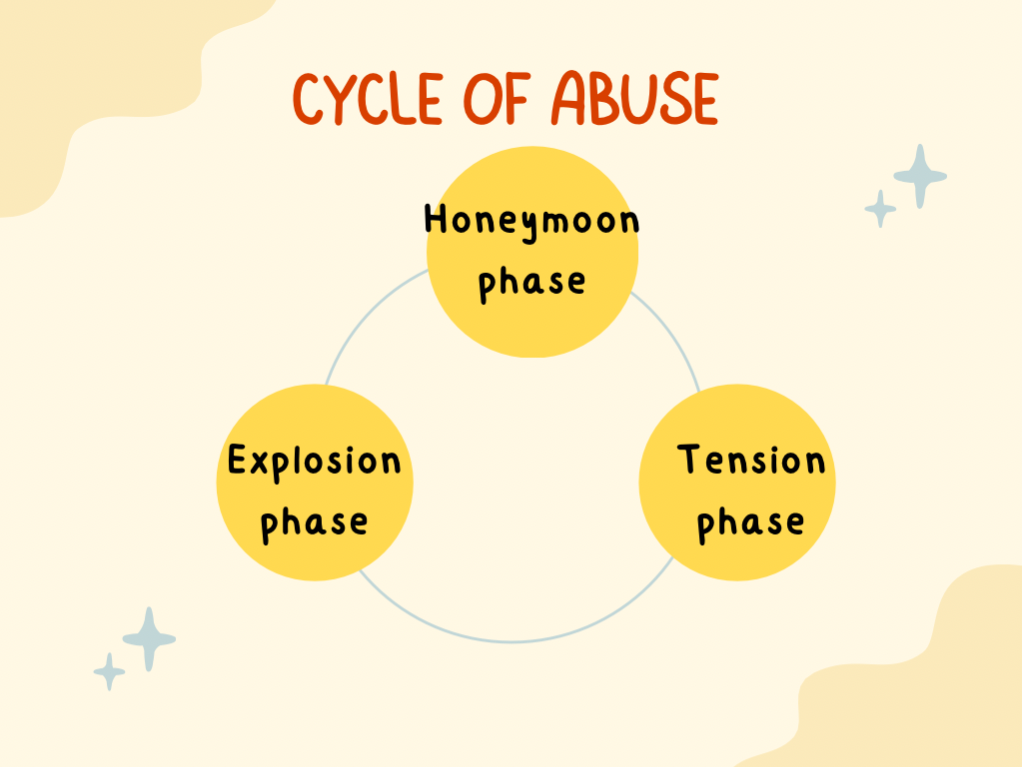Abuse may seem random and without a pattern, but this is usually not the case: it has a pattern and stages that serve different purposes.
The cycle of abuse has three phases:
a) Honeymoon phase
In this phase, the abuser behaves in a ‘normal’ way. They are loving, helpful, supportive, and may even give gifts. It is during this phase that love bombing happens. The abuser portrays their best side that gives a false sense of hope to the victim, leaving the victim always longing for this side of their partner. The abuser spends lots of quality time with the victim and it is this side of themselves they show to the world if they happen to have narcissist tendencies. The phase can be as short as a few hours to years. Sex in this phase can be phenomenal and the abuser may even agree to or begin counseling.
b) Tension phase
The abuser in this phase may suddenly withdraw and go silent and may even ghost their victim. They are distant, withdrawn, and may display hostile or angry behaviors. In other cases, the abuser may be sarcastic, emotionally distant, or have mood swings. They may accuse, insult or threaten the victim. Since it immediately follows the honeymoon phase, most victims tend to assume it must be because of something they have done wrong, or something they did not do. The abuser may justify their behavior by saying that the victim triggered their response, or they could blame their work or social circumstances for this behavior.
The victim has a constant feeling of walking on eggshells and constantly tries their best to reach out and love their partner to have them go back to the honeymoon phase. This phase can last from hours to months.
c) Explosion phase
During this phase, there is an attack on the victim. This attack can vary from the abuser raising their voice at you to experiencing physical, verbal, psychological, or sexual attacks. They could slam doors, push you or swear. In some instances, this could pose a real physical danger to the victim. In longer-term relationships, this phase initially began as simple acts that caused you distress such as yelling or banging a door at you. These may become more brutal or frequent over time. The explosion phase does not last too long and is immediately followed by remorse and a resumption of the honeymoon phase.
The abuser may apologize, cry or even give gifts to make amends. They promise not to act in an explosive manner again. Since the victim is often a caring person, they accept the apology, forgive and give them another chance. The cycle then continues.
These phases do not always occur in this order and the relationship may swing from honeymoon to explosion or the honeymoon period may disappear.
There is confusion brought about by the honeymoon phase and this is what keeps most victims in abusive relationships. During the explosive phase, the terror and fear cause the victim to want to leave the relationship. They may even make exit plans but then their partner changes and becomes so loving that the victim re-engages in the relationship and shelves any exit plans they had. They raise the victims’ hope so much they hook them into the relationship. The victim then gets to work trying to be at their best behavior to ‘avoid’ another explosive phase. This causes the victim to constantly be in a state of fight or flight. Their bodies are flooded with hormones that in the long term will be detrimental to their physical health.
The honeymoon phase is also a controlling phase. The victim is not in control of what is offered as an amendment or gift and has no choice whether to accept this gift or not. Take the case of a partner who brings you lingerie after an explosive phase where the abuser was sexually abusive: do you feel ready to accept this gift? Are you free to reject it without fearing the consequences?
A genuinely given gift is one not imposed on the person receiving it and is entirely for the good of the receiver. If the receiver is not free to reject the gift, or it does not serve their need, this means the gift is given to serve the need of the giver: their need to remain in control. In some instances, it may be advisable to accept the gift as failure to do so may trigger another explosion that could potentially harm the victim. Some of the gifts are meant to exert even more control
Further confusion is brought about by the fact that the abuser displays their remorseful side to any external parties. These people do not, therefore, understand the victim’s desire or attempt to exit the abusive situation when the abuser ‘has made amends’ and may accuse the victim of being ‘unwilling to work on the relationship’.
Task
Complete a relationship cycle for yourself. Describe the behavior your partner exhibits in the various phases of your relationship.
- Honeymoon phase
- Tension phase
- Explosion phase
© When Love Hurts. Do not copy or distribute without permission.


